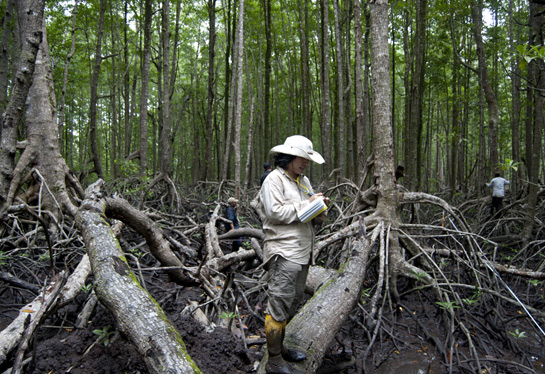- Bringing logging companies in line with FSC certification standards in the Congo Basin
- Building knowledge about climate change adaptation in Congo Basin
- New 10-year research initiative to protect forests and reduce risks for forest communities
- Bioenergy, sustainability and trade-offs
- Landmark findings show mangroves key to fighting climate change
- Rural poor rely on forests for nearly a quarter of household income
- Integrating the management of timber and non-timber forest products in the Amazon
- Reviving frankincense and myrrh for livelihoods and conservation in Ethiopia
- Urgent call for action at Forest Day 5
- Shining a spotlight on Indonesia’s forests
- Pathways to impact

Landmark findings show mangroves key to fighting climate change
After a flight to a seaside town in Indonesia, a group of scientists travels 20 hours by boat to an inland riverine site where they spend a week, waiting for each day's low tide to clamber across a web of roots and knee-deep mud to reach a remote mangrove forest.
So began the grunt work that led CIFOR to pivotal findings – pointing to mangroves as ideal repositories to keep carbon out of the atmosphere and sequestered in forests – that are having significant implications for local and global policies.
The scientists unfurl measuring tape and jot down the circumferences of trees. They unload some 12 kg of stainless steel rods, bore them into the ground, and pry them out to collect core samples: at one metre deep, dirt that is gritty with leaf bits, and at more than 11 metres deep, earth that is black and slick as grease.
Slathered in mosquito repellent to guard against dengue fever and malaria, the scientists work quickly as the tide rises. They swim back to the boats. Back in the laboratory, they analyse the carbon in thousands of soil samples from across Southeast Asia. They crunch their numbers and are astounded by the results: mangroves store three to four times more carbon than most tropical forests.
"Mangroves are being destroyed at an alarming rate and this needs to stop. ... There is an urgent need for governments to acknowledge their importance and develop better policies to ensure their protection."
Daniel Murdiyarso
CIFOR Senior Scientist
Mangroves occur along the coasts of some 118 countries, but up to half of them have been destroyed in the past half century.
A spike in greenhouse gases has warmed Earth by 0.7°C over the past century, brewing an ever more turbulent blend of storms, floods, landslides, forest fires, temperature extremes and droughts.
‘Mangroves are being destroyed at an alarming rate and this needs to stop,’ said Daniel Murdiyarso, CIFOR Senior Scientist. ‘There is a lack of awareness of the full implications of mangrove loss for humankind. There is an urgent need for governments to acknowledge their importance and develop better policies to ensure their protection.’
Since the mangrove findings were published in 2011, they have received worldwide attention from the media, general public and scientific community. The findings will be fed into the Intergovernmental Panel on Climate Change processes as it revises its guidelines for greenhouse-gas inventories in wetlands.
To further enhance the impact of the findings, the Tropical Wetlands Initiative for Climate Change Adaptation and Mitigation (TWINCAM) was developed by CIFOR in partnership with research institutions, donor communities and regional academic partners. This includes networking and capacity building across the globe to assess carbon stocks and greenhouse gas emissions from tropical wetlands.
The topic also received attention at the national level. In Indonesia – home to the biggest area of mangroves in the world, with close to 3 million hectares scattered across the archipelago – CIFOR hosted a journalist workshop on wetlands. Some 17 national journalists attended the workshop and the subsequent field trip to a mangrove forest, and more than 30 stories were published in major newspapers across the country.
